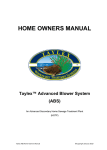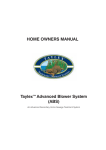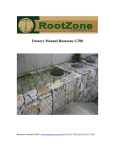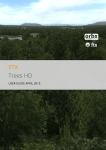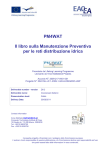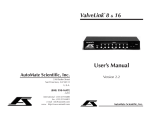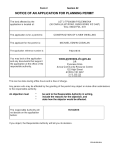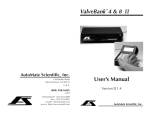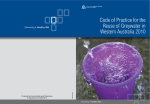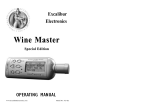Download Nature Flow® Mk II STP Owners Manual 2010
Transcript
Nature Flow® Mk II STP Owners Manual 2010 NATURE FLOW® MK II STP OWNERS MANUAL ® The Nature Flow Mk II Sewerage Treatment Plant requires minimal intervention by the owner. The system should be serviced annually or as per your maintenance agreement by qualified service personnel as advised by the supplier/installer of the equipment. The Nature Flow® Mk II, 10-20 Person On-site Sewerage Treatment Plant was approved for use in Queensland by Type Specification Approval No 514 dated 17 November 2000. A copy of the entire specification approval document may be found at www.natureflow.com.au, or by request from your installer. Alternatively this document is also available from the Department of Infrastructure and Planning at www.dip.qld.gov.au or by telephoning 07 3237 0368. The Nature Flow® Mk II On-site Sewerage Treatment Plant meets the requirements of the Queensland Plumbing & Wastewater Code dated 21/04/2010. FOR YOUR NEAREST SERVICE REPRESENTATIVE 1. Contact your facility builder/installer. 2. Contact Nature Flow Systems on 07 4128 8019 or via email at [email protected]. In the event that a problem occurs with the plant within the first year from date of commissioning please contact your facility builder/installer. In the event that a problem occurs with the plant and the plant is older than one year please contact your service agent. We have a 24hr assistance mobile number 0429 099 902 if there is no answer leave a message LEAVE YOUR NUMBER and someone will call you back. © Nature Flow Systems Pty Ltd O Rev1-01/11/10 Page |1 Subject to change without notice Nature Flow® Mk II STP Owners Manual 2010 CONTENTS PAGE SUBJECT 3 Precautions & Disclaimer 4 Introduction 4 Operation 5 Basic Layout of Treatment Plant 6 Looking after your HSTP – Cleaners 8 Operating & Maintenance Resposnibilities of the Owner 10 Instructions for checking & replenishing chlorine tablets. 11 Operating & Maintenance Responsibilities of the Service Agent 12 Service Related Responsibilities of the Installer 13 Sludge Removal 13 If the plant is to be used intermittently or if periods of non-use are anticipated. 13 Methods & Criteria to be used to identify plant malfunction or problems. 17 Service Contract Typical 18 Warranty General 20 Change of Ownership 21 Contact Details – Facility Builder/Installer ATTACHMENTS √ or × Attach documents below as appropriate to each installation. Place a tick or cross beside to confirm attachment. Material Safety Data Sheet – Chlorine Tablets Material Safety Data Sheet – Ultra Violet Lamps √ Submersible Pump (Pump Well 1) Owners Manual √ Submersible Pump (Pump Well 2) Owners Manual Chlorine Contactor Owners Manual UV Disinfection Unit Owners Manual © Nature Flow Systems Pty Ltd O Rev1-01/11/10 Page |2 Subject to change without notice Nature Flow® Mk II STP Owners Manual 2010 PLEASE READ THROUGH THIS SECTION FIRST. Precautions Maintain the highest regard for your personal safety at all times. Servicing by service agent is recommended and may be mandatory by State/Local Authority. Refer to MSDS attached to this manual for chlorine tablets and/or ultra violet lamps. Refer to owners manual for submersible pumps attached to this manual. Refer to owners manual for chlorine contactor and/or UV disinfection unit attached to this manual. Disclaimer This information booklet is provided as a guide only. While every effort has been made to ensure that the information contained in this guide is accurate and complete, no liability can be accepted for any errors or omissions. Nature Flow Systems Pty Ltd reserves the right to change the specifications of the products and procedures described herein at any time without notice. No part of this guide may be reproduced, transmitted, transcribed, stored in a retrieval system, or translated into any language in any form, by any means, without the prior written permission of Nature Flow Systems Pty Ltd. Nature Flow Systems Pty Ltd makes no warranties for damages resulting from use of this guide. Nature Flow Systems Pty Ltd accepts no liability for damages of any nature resulting from use of this guide. Nature Flow® is a registered trademark of Waterpac Patents Pty Ltd. The “environmentally friendly system” tick logo is a registered trademark of Waterpac Patents Pty Ltd. Other names and products not mentioned above may be registered trademarks or trademarks of their respective companies. © Nature Flow Systems Pty Ltd O Rev1-01/11/10 Page |3 Subject to change without notice Nature Flow® Mk II STP Owners Manual 2010 INTRODUCTION An on-site sewerage treatment plant is a purpose built system used for the treatment of sewerage and liquid wastes from a single household or multiple dwellings. Also know as an Aerated Waste Water Treatment System (AWTS), Household Sewerage Treatment Plant (HSTP), On Site Sewerage Facility (OSSF). The types of waste that can be effectively treated by the plant include natural household waste eg everything you use in your house that goes into your drains, kitchen, laundry, toilet, shower etc. When working properly your HSTP will work efficiently and effectively with no odours and little intervention required by the homeowner apart from basic care. OPERATION Primary 1 – Used to collect all black and grey water. The large size of primary collection increases the retention time and the quality of the treated wastewater. A large proportion of the solids settle to the bottom of this chamber prior to the effluent flowing to the second primary through a suspended solids filter (Zabel or equivalent). Primary 2 – This second primary chamber/tank allows the effluent to settle further before it passes through a suspended solids filter to the media filter pump well. Pump Well 1 – A submersible pump with high level alarm is used to pump wastewater through the media filter and returned via the drainback to pump well 2. Media Filter – The use of in-ground media filter provides a significant surface area increasing the quality of the wastewater treatment. Wastewater is pressure fed through PVC rafts (perforated) to ensure that the whole of the media bed is effectively used and to avoid channelling. The type of media filter varies depending on the installation. Pump Well 2 – wastewater is relatively clear. A submersible pump with high level alarm is used to pump wastewater through the final disinfection method. Disinfection via chlorine contactor and/or ultra violet disinfection unit. Disposal: Site dependant – surface or subsurface as per site assessment and/or State/Local Authority requirements. Refer AS/NZ1547:2000 and Qld Plumbing & Wastewater Code 2010. POWER CONNECTION Your Nature Flow® MkII STP is NOT to be hardwired. Standard installations will require a minimum of three (3) weatherproof GPO’s located at the tank. Warning: When servicing or attending your Nature Flow®, always ensure power is switched off and lead unplugged. Electrical connections should be serviced only by qualified persons. Audible and visual UV lamp failure and/or high water alarms will only work when the unit is connected to the correct electrical supply. 240VAC mains power required at the unit. Electrical Power Surge Protection An electrical power surge or spike can travel on the supply lines and cause serious damage to your electrical equipment. If the installation is subject to electrical power surges or lightning we strongly recommend the use of suitable surge protection devices on ALL electrical equipment. Nature Flow Systems also recommend the use of an RCD or earth leakage circuit breaker (safety switch) on the power supply of your unit. © Nature Flow Systems Pty Ltd O Rev1-01/11/10 Page |4 Subject to change without notice BASIC LAYOUT OF TREATMENT PLANT Nature Flow® Mk II STP Owners Manual 2010 © Nature Flow Systems Pty Ltd O Rev1-01/11/10 Page |5 Subject to change without notice Nature Flow® Mk II STP Owners Manual 2010 LOOKING AFTER YOUR HSTP The greatest causes of problems with your treatment plant are cleaning products and the washing machine. DO I HAVE TO USE ANY SPECIAL TYPE OF DETERGENTS AND WASHING POWDERS? PLEASE NOTE: The following information is not intended to promote or discredit the product of any Company. It is provided to assist in ensuring the satisfactory on-going operation of your system. To protect the environment and ensure the longevity and optimal performance of your Nature Flow® HSTP we recommend that you use environment friendly detergents and cleaners. Using cleaners and detergents that contain high levels of ammonia (eg bleach) and/or phosphorus is hazardous to the biological health of your HSTP. These types of cleaners kill off the natural bacteria and micro-organisms used to treat the primary effluent. Reduction of the natural bacteria of your HSTP will result in a much lower level of primary treatment and may produce unpleasant “septic” odours. High levels of nitrogen and phosphorus also contribute to the growth of algae and other less desirable microorganisms in the environment eg algal growth in waterways. Environment friendly cleaners are those cleaners that either use no chemicals or reduced levels of chemicals. Washing powders/liquids may use labelling that indicates the phosphorus level of the product. Look for the following symbols on the packaging of cleaning products: P This symbol lets you know that the product complies with the agreed Australian industry standard on phosphorus, which imposes a maximum content of 7.8 grams per wash. The standard is designed to reduce the amount of phosphorus entering Australian waterways. NP This symbol lets you know that the product contains no added phosphorus. Levels of 0.5% may be present. SUITABLE PRODUCTS - All products should be used in moderation DISWASHING LIQUIDS Adds Morning Fresh Bushlands Rix Palmolive Sunlight Greenapple Kit Finish for Dishwashers (limit quantity) SURFACE CLEANERS Jiff Cream Cleaner Spray & Wipe (limit quantity) Nifty Swipe Shower Power Windex TOILET CLEANERS Jiff Cream Cleaner or any cream cleaner – Toilet fresheners are not recommended. FLOOR CLEANERS Use hot water and detergent LAUNDRY POWDERS AND LIQUIDS We highly recommend visiting this independent website www.lanfaxlabs.com.au for further information on laundry products. They have a concise, comprehensive and independent brochure detailing laundry products that is available for free download. © Nature Flow Systems Pty Ltd O Rev1-01/11/10 Page |6 Subject to change without notice Nature Flow® Mk II STP Owners Manual 2010 AVOIDABLE PRODUCTS ANTIBACTERIAL SOLUTIONS Antibiotics Nappy Plus Pineoclean Blue Loo Napisan Preen Soaker Bio-Ad Nappy Soft Tri-zyme Bio Jo Nappy Fresh Toilet Duck Milton Tablets Nursil Toilet Cleaners BLEACHES Domestos Lemon Bleach White King Budget Lemon Zixo Fiesta Marvolinn OTHER CLEANERS Ajax ESP Herbal Metho or Kero Swipol Aussa Exit Mould Flea, Tick Wash Handy Andy Bubble Baths Floor Cleaners Spirits/Alcohol Draino Caustic Oven Cleaners Green Choice Down to Earth QUICK TIPS – DO’S & DON’TS DO Try to evenly spread your washing over a period of a week. Avoid where possible to wash everything in one day. It puts to much water in the system and your HSTP will struggle to cope. Liquid soaps breakdown easier than granulate styles do. Try not to be heavy handed with the amount of soaps you use. Use only recommended biodegradable products that don’t contain disinfectants. Any product used that kills bacteria is harmful to your system. If you wish to use some of the harsher cleaning products, it is suggested that you use a bucket and discard the contents in the garden. This also applies to disinfectant, surface sprays and wipes. The use of toilet paper that disintegrates easily is recommended. With a new installation or immediately after a pump out, it is essential that the tank be filled with water. The build up of sludge in the bottom of the primary/secondary sectors of the treatment system must be removed regularly (approx every 5-10 years). Maintain mosquito proofing on all vents. Mosquitoes can breed rapidly in the environment of a sewerage tank. Ensure that your disposal area is operating as designed – wastewater should be disposed of evenly over the entire irrigation area. Avoid ponding. Move sprinkler hoses regularly (ensure hoses are not kinked and sprinklers are not blocked). Maintain signage. DON’T: Do not allow foreign objects, (eg. Nappy liners, disposable nappies, tampons, pads, condoms etc) to enter the system. Pouring large quantities (1/2 litre or more) of beer, wine, milk or fruit juice into the system should be avoided as it can upset the balance in your system. Do not use garbage grinders or insinkerators. Do not cover tanks with earth, cement, paver or any material. Do not prevent quick and easy access to any inspection openings. Do not allow roof or surface water to enter any part of the system. Ensure that diversion mounds around the media filter bed are maintained. Direct surface water away from media bed and treatment tank and ensure that stormwater/rainwater outlets do not discharge in the treatment area. THINGS TO ABSOLUTELY AVOID: Chlorine, disinfectant, bleaches, caustics and heavy chemical products, nappy san, antibacterial products, fat, oil, grease, milk, etc are some of the types of products that will cause the bacteria to die off in your HSTP. © Nature Flow Systems Pty Ltd O Rev1-01/11/10 Page |7 Subject to change without notice Nature Flow® Mk II STP Owners Manual 2010 OPERATING & MAINTENANCE RESPONSIBILITIES OF THE OWNER CARE OF THE SYSTEM – BY THE OWNERS The Nature Flow® Mk II Sewerage Treatment Plant is an ON-SITE treatment system. The system has adequate capacity to accept the usual household products, such as soaps and detergents, provided they are used in moderate quantities. However, the householder is responsible for the continued safe and efficient management of the system and undertakes to avoid practices and products that are harmful to the biological treatment processes. GOOD PRACTICE AVOID or MINIMIZE Use phosphate free or low • Strong acid cleaners / ammonia phosphate detergents and cleaners. products • Chlorinated products / sterilizing agents • Antibiotics (as much as possible) • Hobby and home industry chemicals Stagger wash days to avoid heavy and continuous hydraulic loads. Primary Tank – De-sludge when required. Media Filter • Keep air vents clean. • No motor vehicles over media filter to avoid crushing of distribution pipes which are close to the surface. • Do not plant shrubs/trees with invasive roots near filter bed. Pump Sump – Maintain watertightness to prevent water and grass entry. Annual Inspections – As per council requirements. These products may destroy the anaerobic efficiency of the system. Fats and greases which are extremely slow to decompose – these materials are best disposed of by some other means. Irrigation areas • As per AS 1547:2000 • Effluent shall not be used for irrigation of fruit or vegetables. • The Owner undertakes not to use the irrigation areas for active recreation whilst there is any surface effluent evident. WARNING: Some insects, such as small ants, find electrical devices attractive for various reasons. If your site or enclosure is susceptible to insect infestation you should implement a suitable pest control plan. © Nature Flow Systems Pty Ltd O Rev1-01/11/10 Page |8 Subject to change without notice Nature Flow® Mk II STP Owners Manual 2010 MAINTENANCE – BY THE OWNER 1. Ensure that a quarterly inspection of the chlorine tablet level is carried out and chlorine tablets are replenished when required. Refer to instructions for checking and replenishing chlorine tablets section of this manual. (Chlorine model only.) DO NOT ADJUST THE DIAL CONTROL VALVE OR BYPASS VALVE ON FEEDER TYPE CHLORINE CONTACTORS. These are set at time of installation and should only be adjusted by authorised service personnel. 2. Ensure your system is serviced as per the manufacturer’s recommendations and State/Local authority requirements. Most domestic installations require annual servicing by an appropriately qualified person. This is a local authority (council) requirement and will be enforced. 3. Follow the guidelines outlined in Care of the System by the Owners section of this manual. Maintain awareness of cleaning agents used. NEVER drive any type of vehicle over your sand filter as this may result in damage to underground pipework. 4. Keep the area around the tank and media filter mown. Do not allow grass to become overgrown. 5. Maintain access to the top of the tank. Manhole lids MUST be accessible at all times. 6. Do not plant trees or shrubs in or close to the media filter bed. Do not plant trees or shrubs with invasive root systems close to the tank. 7. Maintain your disposal field. NEVER drive any type of vehicle over your disposal field as this may result in damage to underground pipework. a. Where surface irrigation is used, ensure that the area is regularly mown, maintain vegetation (ie no bare patches of ground) and regularly alternate sprinkler between irrigation areas. b. Where subsurface irrigation is used, ensure use of non-invasive plants, maintain mulch cover of pipework at all times. 8. Ensure landscaping does not divert stormwater in the vicinity of the media filter or in the dispersal field. Maintain or construct (if required) retention and diversion mounds to ensure run-off is guided appropriately. Contact your supplier/installer or service agent should you require any further information. Further Tips… Irrigation System Irrigation lines, spray heads etc can clog up over extended periods of use. Ensure hoses remain unkinked and sprinkler heads unblocked. Some systems with subsurface irrigation may have 1 or 2 in-line filters. These must be removed and cleaned at every service however as the homeowner you should be aware of where they are located in case they require cleaning in between services. Plumbing Problems Blockages in the drainage pipes from the house to the system are plumbing problems. If youe household fittings are not draining away, please check the inlet to the system for blockages. Usually the lines can be cleared at the inlet point by inserting a rod down the pipe. Should this not be possible please call your local plumber or drainer. The loss of a water seal in fittings, allowing gases to escpae, should be initially referred to your local plumber for corrective measures. An incorrectly contructed E Duct Vent coul dbe the cause of this problem. E Duct Vents should be constructed to ensure the proper dispersal of gaseous by-products prevalent in all forms of sewerage treatment. The vent should be positioned at least 60mm above the highest point in the house so the prevailing winds will carry away such gases. Don’t Panic! If the alarm sounds, PLEASE refer to the Troubleshooting Guide in this manual before calling your installer/service agent – this may help keep your costs down! © Nature Flow Systems Pty Ltd O Rev1-01/11/10 Page |9 Subject to change without notice Nature Flow® Mk II STP Owners Manual 2010 INSTRUCTIONS FOR CHECKING AND REPLENISHING CHLORINE TABLETS. Visual inspections should be carried out by the Owner every three (3) months. Exercise extreme caution when opening or servicing your feeder. Always switch off power supply before opening. Do not inhale any fumes from any chemical feeder or container. Protect your eyes, skin and clothing from chemicals at all times. Refer to Materials Safety Data Sheet for chlorine tablets for further information. If additional tablets are required contact your manufacturer/service agent to obtain the correct chlorine tablets. The chlorine tablets used in your system are slow-dissolve Trichloro-S-Triazinetrione (Tri -Chlor). (Chlorine tablets are all different and the tablets used within this system are of a specific composition.) Never add liquid chlorine or chlorine tablets of a different composition to your system. No other type of chemical should ever be used in your chlorine feeder. Step 1: Read and understand MSDS – handling, storage and first aid procedures for chlorine tablets. Step 2: Turn HSTP off at power point and unplug. Step 3: Remove lid on poly cabinet (screws on side of lid). Step 4: Unscrew lid on canister anti-clockwise. DO NOT INHALE ANY FUMES FROM ANY CHEMICAL FEEDER OR CONTAINER. Release lock tab to allow lid to unscrew. Take care not to cross thread the lid when unscrewing from the canister. An O’Ring is used to seal the lid – ensure that care is taken when the lid is removed not to damage this O’Ring. Step 5: Check level of remaining chlorine tablets. If less than 5 full tablets remain then canister requires refilling. (A packet of 5 chlorine tablets lasts approx 3 months for a standard household of 4 people.) Step 6: Wear gloves & eye protection. Replenish chlorine tablets if required. NB: When adding the chlorine tablets do not touch the tablets. Hold the middle of the packet. Carefully split the bottom of the packet while holding it over the chlorinator container and allow the tablets to gently fall into the unit. Avoid chemical contact Do not drop the tablets into the unit. Step 7: Grease O’Ring with a non petroleum based lubricant (rubber grease or similar) before replacing lid on canister. (Regular lubrication is necessary to allow for easy cover removal.) Ensure O’Ring is placed correctly into groove. Replace the lid on the canister. Screw clockwise to tighten. Take care not to cross thread. DO NOT OVERTIGHTEN! The lid has a lock tab mechanism – do not overtighten past this point. NB:If O’Ring is stretched (ie sits loose in the groove) then it must replaced. See your service agent or installer. Step 8: Replace lid on poly cabinet. Step 9: Plug leads back into power points and turn on. Remember that this is a quarterly requirement. Checking the level of chlorine tablets should be carried out every three (3) months. This is the householder’s responsibility. Please contact your service agent or installer should you have any questions or require further information. © Nature Flow Systems Pty Ltd O Rev1-01/11/10 P a g e | 10 Subject to change without notice Nature Flow® Mk II STP Owners Manual 2010 OPERATING & MAINTENANCE RESPONSIBILITIES OF THE SERVICE AGENT SERVICING Home sewerage treatment plants are required by state law to be serviced on a regular basis. The service interval varies between different brands of treatment plants. Your local Council also enforces these laws. Systems may only be serviced by registered licensed wastewater service personnel. Nature Flow® HSTP’s should be serviced annually (unless otherwise recommended). MAINTENANCE SCHEDULE – BASIC Primary Chambers 1 and 2 Pump Well 1 (MF) Media Filter(s) Pump Well 2 (Disposal) UV Disinfection Unit Chlorine Disinfection Unit Disposal Field Diversion/retention mounds Clean suspended solids filters on outlet. Hose any matter off the filters back into the primary chamber of the tank. Check operation of alarm by pressurising clear alarm tube connected to control box. Check pump & high level alarm operation. Check for ponding. Check drainback to pump chamber. Check air venturi – ensure carbon filter in good condition. Advise owner on general state of maintenance around treatment plant (i.e. mowing, weed control, fencing, signage etc). Check operation of pump & high level alarm. Check unit operation. Service every 12 months at minimum. Refer to manufacturer’s recommendations (owner’s manual etc). Replace cleaning felts and o’rings. Replace UV lamps as required (intermittent operation). Replace UV thimble as required. Check unit operation. Check chlorine tablet level and replenish if required. Service every 12 months. Check condition of o’ring (if applicable) that seals the lid to the chlorinator. Take care when screwing lid onto unit that the o’ring is correctly located. Check and service rotary valves (if applicable). Check for ponding. Advise owner on general state of maintenance around disposal field (i.e. mowing, weed control, fencing, signage etc). Check sprinklers for blockage. Clean inline filters, flush out lines. Check condition of mounds and advise owner of any maintenance requirements. Reference Documents Due to the geographical coverage of the Nature Flow® Mk II STP components may be sourced from various manufacturers. Reference should be made to the applicable manufacturer’s manuals in regards to specific maintenance and/or operation of any proprietary components such as submersible pumps, UV unit, Chlorine contactor, Zabel or equivalent filter etc. Refer also to “Service Contract” in this manual. © Nature Flow Systems Pty Ltd O Rev1-01/11/10 P a g e | 11 Subject to change without notice Nature Flow® Mk II STP Owners Manual 2010 SERVICE-RELATED OBLIGATIONS OF THE INSTALLER The installer shall provide the owner with: 1. Copy of this Owner Manual. 2. Copies of owner manuals for pumps, control/electrical equipment, disinfection units etc as appropriate to each installation. 3. Signed copy of commissioning certificate. The installer shall inform the owner of the following: 1. Service requirements of the plant. Annual servicing is required. Installer is to ensure a service contract is signed by the owner for the service due at the one year anniversary date (from commissioning). The cost of this service and all future services remains the responsibility of the owner. 2. A brief “education” is to be provided to the owner usually at the time of commissioning for the basic care and maintenance of the system by the owner. 3. Advise the owner that full specifications of the plant can be obtained from the Department of Infrastructure and Planning at www.dip.qld.gov.au or by telephoning 07 3237 0368 as per details at the start of this manual. The installer shall provide the following information: Component Model Manufacturer Submersible Pump Pump Well 1 Submersible Pump Pump Well 2 Treatment Tank (s) Chlorine Contactor UV Disinfection Unit In the event that a problem occurs with the plant within the first year from date of commissioning please contact your installer. © Nature Flow Systems Pty Ltd O Rev1-01/11/10 P a g e | 12 Subject to change without notice Nature Flow® Mk II STP Owners Manual 2010 SLUDGE REMOVAL Periodic removal of accumulated sludge from the treatment tank (primary chambers 1 and 2) will be required. Sludge build-up by volume has been calculated on the basis of 80 litres per person per year. Thus it will be calculated that desludging of the plant on full 20EP loading would be on a 3 to 4 year cycle. A standard 10 EP (10 person) plant will require sludge removal approx every 6-8 years. Sludge should be removed by an authorised septic pump out contractor. After desludging and cleaning out by pumping, the tank should not be disinfected or washed. All that needs to be done is to fill the tank with water (fill primary chamber 1 and allow to flow through to primary chamber 2) to reproduce the bacterial action and keep odours to a minimum. Do not contaminate Pump Well 2 (disposal chamber). Your service agent should measure sludge level and advise you on service report at annual service. If over 750mm tank needs a pump-out. Primary chambers 1 and 2 should be pumped out. System should be filled back to operating level with clear water to prevent any damage to chambers. IF THE PLANT IS TO BE USED INTERMITTENTLY OR IF EXTENDED PERIODS OF NON-USE ARE ANTICIPATED. DO NOT TURN THE TREATMENT PLANT OFF. The system’s power consumption is directly linked to use of the treatment plant. Submersible pumps operate in relation to inflows into the treatment plant. Pumps may continue to operate during periods of non-occupation due to ingress of stormwater/rainfall into the media filter bed. While their operation will obviously be reduced during periods of non-use they must not be turned off to ensure that any water ingress into the treatment plant (outside household flows) may be disposed off. The control box operates continuously using minimal power. It must remain turned on at all times. The control box alerts the homeowner to high levels in the treatment plant and/or UV lamp degradation. The treatment plant is robust and has the capacity to handle periods of non-use without the need for “reactivation”. Simply commence using the system as usual. (Ensure that power to the system is on and that disposal hoses (surface irrigation) are connected and unrolled.) Servicing periods remain mandatory and intervals are not reduced due to periods of non-use. METHODS & CRITERIA TO BE USED TO IDENTIFY PLANT MALFUNCTION OR PROBLEMS. ALARM SYSTEM AND CONTROL UNIT If an alarm condition is detected an audible alarm is produced and the blue strobe (flashing) light will activate. Switching the power off at the GPO silences the alarm. Switching the main power at the GPO off and on will return the system to normal operation. Permanent faults will cause the system to alarm again. Faults of a temporary nature (eg temporary pump blockages or power “outs”) can be cleared by switching power at the GPO off, wait 10 seconds and then switch back on. High Level Alarms indicate a possible pump failure. Refer to Troubleshooting section of this manual for further details. © Nature Flow Systems Pty Ltd O Rev1-01/11/10 P a g e | 13 Subject to change without notice Nature Flow® Mk II STP Owners Manual 2010 TROUBLESHOOTING- GENERAL Servicing by your service agent or other suitably qualified person is recommended and may be a State or Local Authority requirement. Refer to Precautions & Disclaimer at start of this manual. The following points are offered as guide for initial diagnosis of faults and may enable the householder to rectify minor concerns. It is not recommended that the householder undertake any course of action outlined in this trouble shooting guide for which he/she is not confidently and compentently capable of completing. Should the fault occur within the first twelve months following original installation please contact your supplier/installer. For any faults occuring after this period please contact your service agent. A visual (blue flashing light) and audible alarm (buzzing sound) will activate to notify householders of a fault with their treatment system. (Be aware that these alarms will not activate in times of power loss/disturbance.) The alarms will activate in response to a high level of wastewater in the tank (possibly caused due to pump failure/sprinkler hoses blocked etc) or for UV lamp failure (UV Models Only). Identify the two manhole lids that contain the pump chambers. Stand at the green control box on the ground facing the tank. At this position the first two manhole lids on the left hand side are the ones containing the pump chambers. Check level of wastewater in the treatment tank by carefully sliding the manhole lid aside and visually inspecting the chamber. Take care not to catch fingers or other body parts when removing the manhole lid. Ensure that chamber is allowed to ventilate. Do not place head or other body parts into tank. Do not breathe in vapours or fumes from tank. If wastewater is at correct level the pump float switch and/or the pump should be visible. If wastewater is above this level then fault is most likely to be a high level alarm. Refer to section on Troubleshooting – High Level Alarm in this manual. TROUBLESHOOTING – HIGH LEVEL WASTEWATER ALARM The blue strobe light is flashing. Inspection of tank chambers confirms high level of wastewater in tank. This indicates a high level alarm. A high level may be caused due a number of reasons including pump failure, irrigation sprinkler/hose blockages, power failure or groundwater entering the system during rain. Is this the first time you have turned the system on? If the sprinkler is operating the high level is probably caused from the initial volume of water placed in the tank at installation to prevent uplift. Once this initial volume reduces to the appropriate level the alarm should cease. Has there been a power outage? The fault may be caused due to the build-up of treated effluent in the tank due to pumps not operating from power failure. Once power supply is re-established check irrigation area to see if system is pumping out. If the sprinkler is still pumping out then the fault is probably due to a build-up of effluent. The blue light will continue to flash until the high level float has dropped to the prescribed level. Has it rained during the period prior to the alarm activating? The fault may be caused due to groundwater entering the system during rain. Check that the sprinkler is pumping out. If the sprinkler is still pumping out then the fault is probably due to groundwater. The blue light will continue to flash until the high level float has dropped to the prescribed level. Please note that this alarm condition may continue until some time after the rain ceases as the pumps continue to operate to reduce the high level (keeping in mind that it is not only the groundwater but also the everyday production of effluent that must be treated). © Nature Flow Systems Pty Ltd O Rev1-01/11/10 P a g e | 14 Subject to change without notice Nature Flow® Mk II STP Owners Manual 2010 Is the sprinkler pumping out? No – Possible pump failure or blocked sprinkler/hose. 1. Check if the sprinkler/hose is blocked or kinked. a. Check that hose is uncoiled, straight, un-kinked and that the sprinkler key is correctly clicked into place. Turn the system off at the powerpoint. Wait 10 seconds and then turn back on. Wait 2 minutes for time delay to pass and then check if pumping out. Is the sprinkler pumping out? Yes - the fault has been cleared - the blue light will continue to flash until the high level float has dropped to the prescribed level. b. Remove sprinkler head from hose. Turn the system off at the powerpoint. Wait 10 seconds and then turn back on. Is treated effluent being pumped out through hose? Yes – blockage has been removed. Turn the system off at the powerpoint. Replace sprinkler head on hose. Wait 10 seconds and then turn back on. Wait 2 minutes for time delay to pass and then check if pumping out.Is the sprinkler pumping out? Yes the fault has been cleared - the blue light will continue to flash until the high level float has dropped to the prescribed level. 2. Check if the submersible pumps are operating. a. Listen to hear if the pump motors can be heard working. b. Lift the inspection covers and check the levels in the pump chambers. CAUTION: Always take care of your personal safety and that of others. NEVER leave the inspection holes uncovered. ALWAYS replace the covers immediately after inspection. Take care not to catch fingers or other parts of the body when removing or replacing the covers. c. While the inspection hole is uncovered, visually inspect the location of the floats. Are they hanging freely? Are they hooked up on the pump/pipework/tank wall? Always take care of your personal safety and that of others. NEVER stick your head or any other part of your body into the septic tank. Potentially dangerous gases may be produced in septic tanks. The effect of these gases can overcome you very quickly. Is the sprinkler pumping out? Yes - Possible media filter pump failure. Contact your supplier/installer or your service agent. TROUBLESHOOTING - UV UNIT Principle. The basic electrical circuit is like a fluorescent light. Advanced electronic ballast (choke) provides the correct voltage and current for UV globes. A starter is not required as the electronic ballast allows for a “soft-start” providing protection for the UV globe. The circuit board monitors the light from the UV globe and if it is not present, illuminates the blue strobe light and sounds the alarm buzzer (a “buzzing” noise). 1. UV GLOBE OUT, NO ALARM o No mains voltage. o Check mains power connections inside power supply. 2. UV GLOBE FLICKERING, ALARM ON o Failed UV globe. o Incorrect UV globe or ballast fitted. 3. UV GLOBE OUT, ALARM ON o UV globe failed. o Poor connection to UV globe (check/clean connector/UV globe pins). o Ballast failed (unlikely). 4. UV GLOBE ON, ALARM ON o Faulty circuit board, loose connection or lamp sensor. Lamp sensor incorrectly installed. © Nature Flow Systems Pty Ltd O Rev1-01/11/10 P a g e | 15 Subject to change without notice Nature Flow® Mk II STP Owners Manual 2010 5. VIBRATION THROUGH UNIT ON OPERATION (solenoid models only) o Check adjustment of solenoid valve to ensure flow/pressure is regulated appropriately for application. Refer to manual for solenoid valve adjustment procedure. WARNING: When servicing or attending your Nature Flow® System always ensure power is switched off and lead unplugged. Electrical connections should be serviced only by qualified persons. Care should also be taken when servicing or disassembling the unit and associated pipework to avoid possible injury from pressurized water. Unplug power, relieve pressure by opening a tap on the discharge (outlet) of the unit and allow any water in the unit to cool before attempting to dismantle. TROUBLESHOOTING - SUBSIDENCE 1. What is subsidence? Subsidence and/or ground movement is an event caused by Nature – it is unpredictable and extremely difficult to avoid. The degree of subsidence is dependent on individual site conditions including, but not limited to, weather (prior to, during and after installation), soil type and location of installation. It is an event not covered by warranty. 2. What kinds of problems result from subsidence? Subsidence around tanks installed in-ground may result in increased pressure on any pipework connected to the tank. Sometimes this increased pressure will result in the pipework/fitting becoming “sheared off”, stretched or split (leaking) or broken. Defects arising from subsidence are not covered by warranty. Generally subsidence only occurs in the first instance of changed weather conditions (i.e. after rain) however it may occur under other circumstances. Usually after the first instance the ground (and consequently the tank and other componentry) “finds it level” and you should not experience any further problems from this phenomenon. In very reactive soils or other unstable conditions, subsidence may occur again. Defects caused by subsidence are possible in any installation involving tankage and pipework being placed in and below ground. Common minor defects are: • Shearing, leaking or breakage at the poly dispersal line from the HSTP tank to irrigation. • Shearing, leaking or breakage at the PVC pipes between the media filter and HSTP tank. These defects can be rectified by a suitably licensed person. 3. Can anything be done to prevent subsidence? Unless otherwise agreed, all installations are for “loose” backfill only. Following periods of rain/dry depressions around excavations may develop placing strain on the pipework. The best prevention of defects caused by subsidence is simply to be aware of the possibility and to maintain vigilance in ensuring these depressions are “topped up” and/or breakages etc are repaired in a timely manner. LIMIT YOUR WATER USAGE IF YOUR SYSTEM HAS FAILED. IN THE EVENT THAT A PROBLEM ARISES OR SERVICE IS REQUIRED REFER TO THE CONTACT DETAILS AT THE START OF THIS MANUAL OR THE LABEL AFFIXED TO YOUR TREATMENT PLANT. © Nature Flow Systems Pty Ltd O Rev1-01/11/10 P a g e | 16 Subject to change without notice Nature Flow® Mk II STP Owners Manual 2010 Nature Flow® Sewerage Treatment Plant SERVICE CONTRACT This Agreement is made between (Owner/Occupier) ___________________________________________ of (Address) and Nature Flow Systems P/L or their duly appointed agent. The duration of the Agreement is for a period of twelve calendar months. Nature Flow Systems P/L or their agent, upon payment of $_________________________ per year plus travel & consumables (where applicable) and the signature of the afore-named person at the place indicated below, and upon acceptance of this application by a duly authorised employee of Nature Flow Systems P/L, agrees, for the period indicated to the following: 1 Annual field service inspection will be made by a trained employee at approximately one year from the date this Agreement is signed (or if the first service after installation then approx one year after the date of commissioning). Inspections include the following checks: a) b) c) d) e) f) g) h) i) j) Efficiency of chlorinator. Check dial up residual and Bypass Valve is set correctly. Level of chlorine tablets (Cost of replenishing chlorine tablets is NOT included in maintenance fee.) Check irrigation and recirculating pumps are operational Amount of sludge accumulation in the septic chamber Zabel filter/or equivalent Media filter vents checked for damage and mosquito proofing Drainback to final effluent chamber is running freely Visual inspection for ponding above filter Condition of all hoses and irrigation sprays Condition of irrigation area Inspection includes the following tests: a) b) c) d) e) f) pH level of effluent Level of dissolved oxygen Temperature of effluent High water level alarms Clarity of water Free residual chlorine level 2 This maintenance agreement does NOT include the maintenance of the irrigation area or repairs to any part of the treatment system, chlorinator unit or pumps. The cost of replenishing chlorine tablets is NOT included in this maintenance agreement. 3 Both labour and materials will be charged for any emergency service call outside the annual service call specified above. 4 All repairs are strictly on a COD basis. 5 This Agreement does not bind Nature Flow Systems P/L or its duly appointed agent to be responsible for the quality of the effluent. However, it will at all times wherever possible, recommend how the effluent quality can be maintained at its maximum and alter and adjust the system during annual service to obtain the best possible effluent standards. In applying for this Agreement, the undersigned acknowledges that this Agreement is binding while they are the owner/occupier of the premises. Nature Flow Systems P/L will transfer the unexpired portion of this contract to any new owner/occupier to comply with the relevant health legislation. I hereby apply for the above Agreement and agree to the annual service fee payable of $_______________ plus travel & consumables (where applicable). (Owner/Occupier’s signature) Accepted the ______________________ day of _______________________, 20______. By: __________________________________________ © Nature Flow Systems Pty Ltd O Rev1-01/11/10 P a g e | 17 Subject to change without notice Nature Flow® Mk II STP Owners Manual 2010 WARRANTY TERMS & CONDITIONS Warranty is subject to the return of a signed Commissioning Certificate (by licensed plumber/drainer who installed the plant). This certificate is to be filled out and returned to the manufacturer as part of the Homeowner’s Warranty Registration. 1. This warranty applies to all states and territories of Australia only and is subject to the provisions of the Competition and Consumer Act 2010 as applicable. 2. Nature Flow Systems Pty Ltd (PO Box 2009 Hervey Bay Qld 4655; ph: 07 4128 8019; [email protected]) warrants to the original purchaser that all equipment manufactured by Nature Flow Systems Pty Ltd is free from defect in material and constructions at the time of despatch from the premises of Nature Flow Systems Pty Ltd. This warranty is subject to due compliance by the original purchaser with our standard terms and conditions of sale, our supplementary standard conditions and our Privacy Policy. 3. This warranty is a return to base warranty which means the item must be returned to the manufacturer for repair. An exchange unit may be provided in this case. If replacement or service under this warranty policy is required and distance prevents you calling personally, forward your product freight prepaid to your nearest Service Provider. 4. This warranty does not extend to any claim made after a fixed period from the date of purchase for the following equipment: Chlorinator 1 year Concrete Treatment Tank(s) 15 years Control Box 1 year Filter Liner 3 years Submersible Pumps 1 year UV Disinfection Unit (excluding UV glassware) 1 year 5. All claims for warranty must be done through the retailer or supplier from whom the product was purchased. Proof of purchase must be supplied. 6. Any claim made in relation to this warranty is limited to the cost of replacement or repair of the equipment or such parts thereof claimed defective. 7. In the case of ancillary parts not manufactured by Nature Flow Systems Pty Ltd such as pumps, starters, switches, tanks, chlorinators, liner etc the warranty extended to the purchaser will be limited to the warranty available from the manufacturer of that part. 8. This warranty is valid only when the equipment has been used in a normal manner and in accordance with the Owner’s Manual and has been serviced at the prescribed service intervals by a service person approved by Nature Flow Systems Pty Ltd. The product must only be connected to 240VAC mains power unless otherwise specified by the manufacturer in writing. 9. This warranty does not cover any equipment that has been improperly installed, misused, neglected, damaged in transport, repaired without authorisation of Nature Flow Systems Pty Ltd, damaged or breakdown by fair wear and tear or altered in any way from its original condition at the date of purchase. 10. Adverse operating conditions beyond the control of Nature Flow Systems Pty Ltd such as improper voltage, water pressure, excessive ambient temperature, water damage, flooding, or any condition that adversely affects the performance or life of the equipment will render this warranty null and void. 11. Any costs incurred to repair a unit that is not covered by warranty will be passed on to the consumer including costs incurred to remove the faulty unit and replace with an exchange unit. Nature Flow Systems Pty Ltd is not responsible for any costs for goods not covered by this warranty. 12. Warranty work will not be performed until the customer has accepted the price quoted for the service call and/or any work not covered by the warranty. 13. Without limiting the original purchaser’s entitlements under the Competition and Consumer Act 2010. Nature Flow Systems and/or its authorised agents shall not be liable for any loss of profits or any consequential, indirect or special loss, damage or injury of any kind whatsoever arising directly or indirectly from the product or any defect. © Nature Flow Systems Pty Ltd O Rev1-01/11/10 P a g e | 18 Subject to change without notice Nature Flow® Mk II STP Owners Manual 2010 14. Where the Trade Competition and Consumer Act 2010 does not apply, Nature Flow Systems and/or its authorised agents shall not be liable for any loss of profits or any consequential, indirect or special loss, damage or injury of any kind whatsoever arising directly or indirectly from the product or any defect and the purchaser shall indemnify Nature Flow Systems and/or its authorised agents against any claim by any other person whatsoever in respect of any such loss, damage or injury. 15. Our goods come with guarantees that cannot be excluded under the Australian Consumer Law. You are entitled to a replacement or refund for a major failure and for compensation for any other reasonably foreseeable loss or damage. You are also entitled to have the goods repaired or replaced if goods fail to be of acceptable quality and the failure does not amount to a major failure. 16. Nothing in this warranty is intended to have the effect of contracting out of the provisions of the Competition and Consumer Act 2010 except to the extent necessary to give effect to that intention. 17. Nature Flow Systems and/or its authorised agents may be collecting personal information only to use this information in accordance with the Provisions of the Privacy Act 1988 (Cth). Warranty does not cover: • Cleaning sprinklers of any blockages or damage to equipment caused by not clearing blockages. • Any operational problems due to extraneous matter, fates or chemical spills in the sewerage. • Any parts broken or stolen from within the system due to transport or installation or misuse by any unauthorised persons. • Any changes that are made to the treatment plant system from the original manufacture that is not approved by the manufacturer including components that may be modified, removed or replaced that alters the treatment processes. • Service Agent’s time for replacement of any faulty parts or cleaning out of the treatment system. • Service Agent’s travel expenses (vehicle and travel time). • Service callout costs. • No warranty if the system has been used as an external power supply for other electrical appliances. • No warranty if the seal on the control box has been broken. © Nature Flow Systems Pty Ltd O Rev1-01/11/10 P a g e | 19 Subject to change without notice Nature Flow® Mk II STP Owners Manual 2010 CHANGE OF OWNERSHIP It is a requirement as part of the standard conditions of supply of a Nature Flow® Sewerage Treatment Plant that you notify Nature Flow Systems Pty Ltd of any change to ownership. STP Site Address Name of Current Owner Name of New Owner Postal Address of New Owner Contact Numbers of New Owner (if known) Landline Fax Mobile Date Effective from Please forward the completed form to: Nature Flow Systems Pty Ltd PO Box 2009 Hervey Bay QLD 4655. Thank you. © Nature Flow Systems Pty Ltd O Rev1-01/11/10 P a g e | 20 Subject to change without notice Nature Flow® Mk II STP Owners Manual 2010 Nature Flow Systems Pty Ltd Ph: 07 4128 8019 Fax: 07 4128 8171 Email: [email protected] Web Address: www.natureflow.com.au Postal Address: PO Box 2009 Hervey Bay QLD 4655 Your system was installed by: Contact your installer or Nature Flow Systems Pty Ltd should you have any questions or require further information, or to arrange for annual servicing of your system to ensure its high level of performance is maintained. THIS INFORMATION BOOKLET SHOULD BE KEPT IN AN ACCESSIBLE AREA AT ALL TIMES. © Nature Flow Systems Pty Ltd O Rev1-01/11/10 P a g e | 21 Subject to change without notice





















